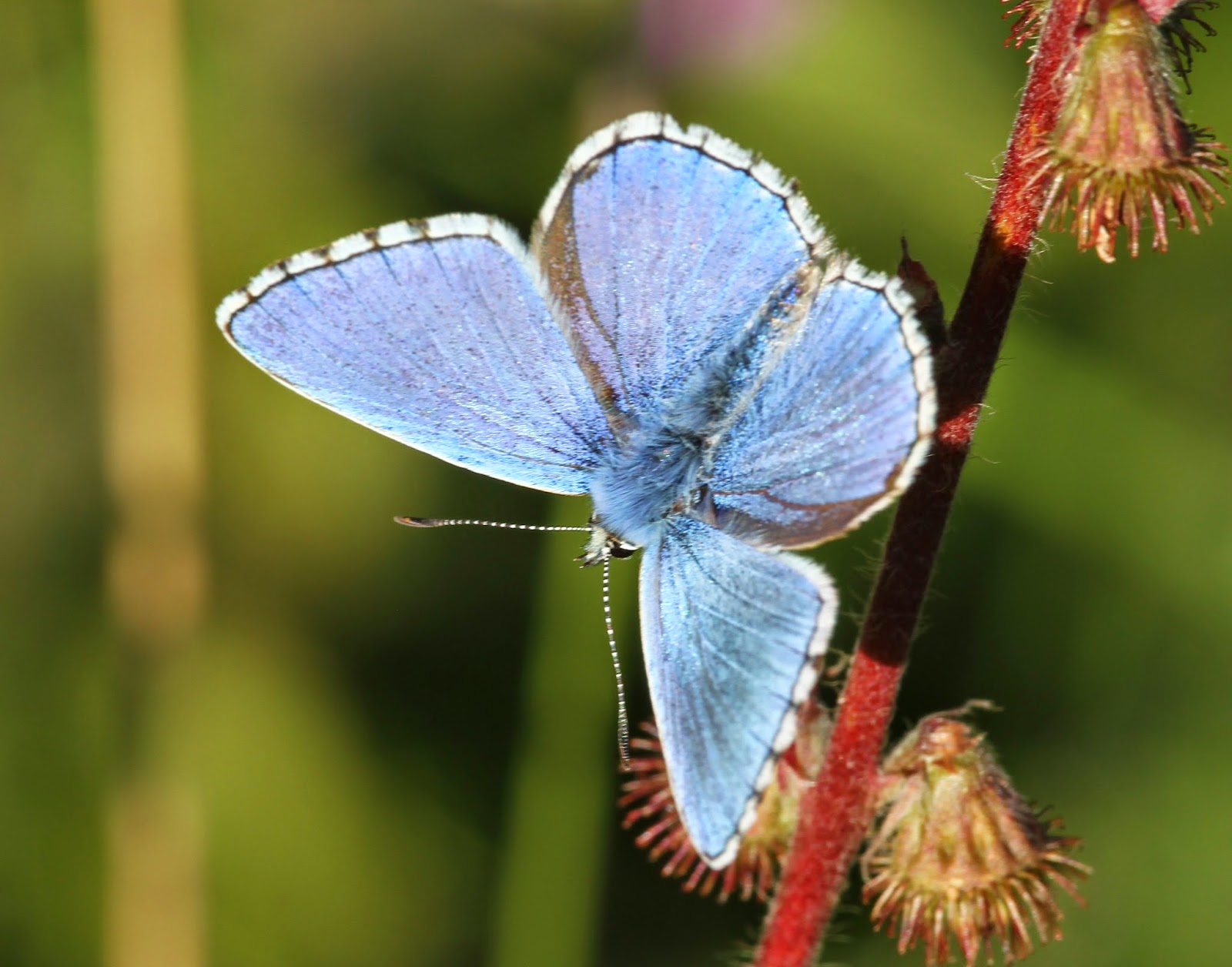It is many years since I've been onto the Eastern half of Darland Banks, so I made the effort to stop at Hoath Close today, and approach the steep downland slope from the East side, and this side does seem to have some different plants in it. You get equally good views across the green gap towards Capstone - its such a valuable lung for Gillingham.
A very nice plant to see a little way along the downland was the Blue Fleabane, Erigeron acer (L.), with its greatly reduced ray florets - remarkably pretty! It is also known as the Bitter Fleabane, and has the Latin synonym Erigeron acris, also from Linneaus.
It is an erect hairy annual or biennial about 3 to 15 inches tall with many linear-lanceolate unstalked leaves running up the upright reddish stem, unbranched until the panicle of inflorescences is reached. I didn't see the described basal rosette of stalked leaves.
The ray florets are only just longer than the yellow disc florets, pink-purple, narrow, erect. The bracts appear to me to be similar in shape, neatly pointed, but in rows of differing lengths, each row clearly overlapping the one above. Within a row they do NOT overlap. Each flower head could only just have been the described diameter of 12 - 18 mm as described in Rose, who may have got it from CTW - I would have said nearer 8 mm, and therefore as said to be less than 10mm in Luontoporti, the Finnish website! I need to go back with a ruler. The ring of white might perhaps be styles, but they could be "intermediate" florets, it is rather unclear. The flower heads themselves are held in a loose panicle of about three to half a dozen heads.
It is typically found on calcareous grassland in the UK and flowers from July to August, but is more broadly regarded as growing in rocky places and dry meadows in countries like Finland, where there are several subspecies known varying in factors such as hairiness, colour and number of inflorescences. It has a distribution that extends across to North America. In Kent it is well-known as a regular on this particular site, and I think found quite generally across the county.
Here is another head, this time just coming into fruit with each pappus joining together to appear as a strawy fuzz above the old disc florets. Stunning colour combination to our eyes!
The Yarrow was also looking good!
A very common plant at the top of the slopes was the Sainfoin, Onobrychis viciifolia, with its salmon pink flowers streaked with darker red.
A very nice plant to see a little way along the downland was the Blue Fleabane, Erigeron acer (L.), with its greatly reduced ray florets - remarkably pretty! It is also known as the Bitter Fleabane, and has the Latin synonym Erigeron acris, also from Linneaus.
It is an erect hairy annual or biennial about 3 to 15 inches tall with many linear-lanceolate unstalked leaves running up the upright reddish stem, unbranched until the panicle of inflorescences is reached. I didn't see the described basal rosette of stalked leaves.
The ray florets are only just longer than the yellow disc florets, pink-purple, narrow, erect. The bracts appear to me to be similar in shape, neatly pointed, but in rows of differing lengths, each row clearly overlapping the one above. Within a row they do NOT overlap. Each flower head could only just have been the described diameter of 12 - 18 mm as described in Rose, who may have got it from CTW - I would have said nearer 8 mm, and therefore as said to be less than 10mm in Luontoporti, the Finnish website! I need to go back with a ruler. The ring of white might perhaps be styles, but they could be "intermediate" florets, it is rather unclear. The flower heads themselves are held in a loose panicle of about three to half a dozen heads.
It is typically found on calcareous grassland in the UK and flowers from July to August, but is more broadly regarded as growing in rocky places and dry meadows in countries like Finland, where there are several subspecies known varying in factors such as hairiness, colour and number of inflorescences. It has a distribution that extends across to North America. In Kent it is well-known as a regular on this particular site, and I think found quite generally across the county.
Here is another head, this time just coming into fruit with each pappus joining together to appear as a strawy fuzz above the old disc florets. Stunning colour combination to our eyes!
The Yarrow was also looking good!
A very common plant at the top of the slopes was the Sainfoin, Onobrychis viciifolia, with its salmon pink flowers streaked with darker red.




















































